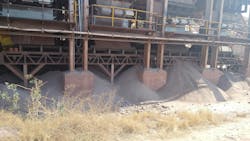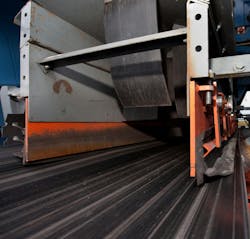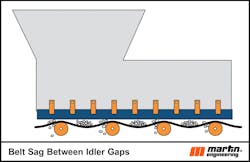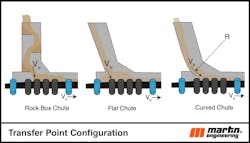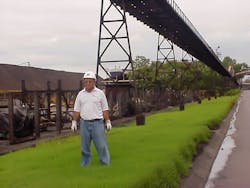Preventing fugitive material from escaping bulk solids belt conveyors
Key takeaways:
- Fugitive material can lead to unplanned downtime, excessive cleaning costs, premature equipment failure, regulatory violations, and safety incidents.
- Fugitive materials generally fall into four categories: spillage, leakage, dust, and carryback.
- To limit fugitive material, careful consideration must be given to capacity calculations, the angle of belt incline, transfer point design, and access for cleaning and maintenance.
Most belt conveyors handling bulk solid materials experience some degree of material loss due to spillage, leakage, dust, and carryback, collectively known as fugitive material. This loss can range from 3% in poorly operated and maintained systems to less than 0.1% in world-class operations.1 Although fugitive materials cannot be completely eliminated from bulk material handling conveyors, the issue can be effectively managed, leading to cleaner, safer, and more productive operations.
Symptoms of the failure to control fugitive materials include unplanned downtime, excessive cleaning costs, premature equipment failure, regulatory violations, and safety incidents. Addressing these symptoms with workable, long-term solutions will enhance performance, housekeeping and safety as well as boost profitability.
Types of fugitive material in belt conveying processes
The nature of a fugitive material problem from a belt conveyor is indicated by the location and particle sizes of the accumulated material. Fugitive materials generally fall into four categories: spillage, leakage, dust, and carryback.
Spillage. Spillage escapes the belt and collects under the conveyor in both the loading and discharge zones. Piles of spillage accumulate rapidly and occur due to overloaded belts, mistracking and insufficiently sealed loading and discharge zones. This is best remedied with a skirtboard liner. A wearliner and a canoe liner protect the enclosure from abrasion wear.
Leakage. Leakage seeps from the conveyor, slowly accumulating in piles. The source of the leakage may not be immediately apparent. Skirting, such as Martin’s Apron-Seal dual skirting, along the skirt board rides the belt, creating a seal that prevents material from escaping.
Dust. Dust commonly escapes via turbulent air at the transfer point. Some studies have shown that working in a dusty environment reduces worker productivity by as much as 20%.2 Combustible dust presents fire and explosion hazards, along with health and safety risks. A modular transfer point kit creates a loading zone, settling zone, and stilling zone, separated by curtains, which controls airflow and allows dust to settle back into the material stream.
Carryback. Carryback refers to fine material that adheres to the belt surface or gets trapped in imperfections after passing the belt cleaners. At the discharge and along the belt’s return path, this material falls beneath the system, generating dust and accumulating, sometimes encasing the belt and rolling components.
Best practices to prevent fugitive material in bulk solids conveying processes
A common production “upgrade” in bulk solids conveying processes is to increase the speed of the belt. However, fugitive material problems are roughly proportional to the speed of the conveyor (or tonnage). If the belt speed is doubled, the fugitive material problem and cost of operation (cleanup, maintenance, equipment replacement, etc.) may also double.
Careful consideration must be given to capacity calculations, the angle of belt incline, transfer point design, and access for cleaning and maintenance. To limit fugitive materials, it is advisable to derate the conveyor capacity to 80-90% of the theoretical capacity and employ slower belt speeds. Loading at an angle of less than 5 degrees and reducing the incline will help minimize flooding and material rollback at the tail.3
Designing a longer and taller skirtboard enclosure with dust curtains will help control airflow and dust emissions. Access for cleaning and maintenance can reduce downtime by 33% and significantly decrease exposure to hazards. If future capacity increases are likely, they should be planned for in the initial design.
Case study: Western Brazil
A bulk handling operation located near a resort area in Western Brazil was facing public outrage due to dust and spillage that were staining the beautiful sandy beaches a deep red. The operation was confronted with daily fines and the risk of closure if the issues were not resolved.
The main focus to solve the problem was on repairing transfer points, replacing idlers, and alleviating some of the most significant material-flow bottlenecks. The benefits were numerous. Spillage decreased from 2.8% to 0.8% of tons conveyed, idler life increased by 30%, belt life improved by 25%, and safety incidents and near misses were dramatically reduced. Operators noticed that most complaints shifted from the fugitive material to the need to mow the grass that grew back underneath the conveyor structure.
However, the most significant benefit was the improvement in conveyor availability, enabling a 33% increase in production without expanding the raw material yard’s receiving and storage capacity.
Fugitive material is not a given with belt conveyors
Managing fugitive material is more economically and operationally sound than merely chalking it up as “the cost of doing business” with belt conveyors. The effect that spillage, dust, and carryback have on an operation is a tangible reminder of unnecessary inefficiency. By working with experts and installing modern solutions to age-old conveyor problems and practicing state-of-the-art maintenance, belt conveyor operators can significantly improve workplace safety and dramatically reduce the cost of operation.
References
1. Staff; Belt Conveyors for Bulk Materials. Conveyor Equipment Manufacturers Association (CEMA) 7th edition, 2021.
2. Hubbard, Douglas W.; How to Measure Anything, Finding the Value of Intangibles in Business. John Wiley & Sons, 2010.
3. Coscione, Marco; Swinderman, R. Todd; Swinderman Scale of Fugitive Material Measurement, Measurement of Fugitive Material for Belt Cleaning Assessment, ENCOM, 2018.
About the Author
R. Todd Swinderman
R. Todd Swinderman is president emeritus of Martin Engineering, a global innovator in the bulk material handling industry for more than 80 years, developing new solutions to common problems and participating in industry organizations to improve safety and productivity. The company’s series of Foundations books is an internationally-recognized resource for safety, maintenance, and operations training, with more than 22,000 print copies in circulation around the world. The 500+ page reference books are available in several languages and have been downloaded thousands of times as free PDFs from the Martin website. Martin Engineering products, sales, service and training are available from 18 factory-owned facilities worldwide, with wholly owned business units in Australia, Brazil, China, Colombia, France, Germany, India, Indonesia, Italy, Malaysia, Mexico, Peru, Spain, South Africa, Turkey, Kazakhstan, the US, and UK. The firm employs more than 1,000 people, approximately 400 of whom hold advanced degrees. For more information, contact [email protected], visit www.martin-eng.com, or call (800) 544-2947.
